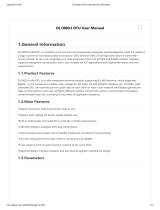
Chengdu Ebyte Electronic Technology Co., Ltd E90-DTU(400SL30-ETH) User Manual
Copyright ©2012–2021, Chengdu Ebyte Electronic Technology Co., Ltd 2
Contents
1. Product Overview............................................................................................................................................................... 3
1.1 Introduction...............................................................................................................................................................3
2. Parameter............................................................................................................................................................................ 3
2.1 General parameter.....................................................................................................................................................3
2.2 Wireless parameter....................................................................................................................................................4
2.3 Dimension and pin definition................................................................................................................................... 5
2.4 Connection method................................................................................................................................................... 6
3 Product function...................................................................................................................................................................7
3.4 Basic function........................................................................................................................................................... 7
3.4.1 SOCKET........................................................................................................................................................7
3.4.2 TCP Client..................................................................................................................................................... 7
3.4.3 TCP Server.....................................................................................................................................................7
3.4.4 UDP Client.....................................................................................................................................................8
3.4.5 UDP Server.................................................................................................................................................... 9
3.4.6 WOR role.......................................................................................................................................................9
3.4.7 Fixed point transmission................................................................................................................................9
3.4.8 Broadcasting and Monitoring...................................................................................................................... 10
3.4.9 Communication key.....................................................................................................................................10
3.4.10 Enable repeater.......................................................................................................................................... 10
3.4.11 Enable LBT................................................................................................................................................10
3.4.12 Enable RSSI byte.......................................................................................................................................10
3.4.13 Enable RSSI environment noise................................................................................................................ 10
3.5 Featured function....................................................................................................................................................11
3.5.1 web page configuration............................................................................................................................... 11
3.5.2 Heartbeat function....................................................................................................................................... 11
3.5.3 Registration package function..................................................................................................................... 12
3.5.4 Short connection function............................................................................................................................12
3.5.5 KeepAlive function......................................................................................................................................13
3.5.6 Timeout restart function...............................................................................................................................13
3.5.7 Clearing the cache function......................................................................................................................... 13
3.5.8 Link/ data transmission indication...............................................................................................................13
3.5.9 Restore to factory setting............................................................................................................................. 14
4 Quick Start.........................................................................................................................................................................14
4.1 Default parameter................................................................................................................................................... 14
4.2 SOCKET instruction...............................................................................................................................................15
4.3 TCP Client guidance...............................................................................................................................................15
4.4 TCP Server guidance.............................................................................................................................................. 16
4.5 UDP Client guidance.............................................................................................................................................. 18
4.6 UDP Server guidance............................................................................................................................................. 19
4.7 WEB introduction...................................................................................................................................................21
Revision history....................................................................................................................................................................23
About us................................................................................................................................................................................23























